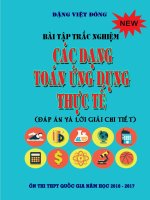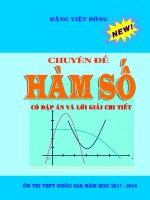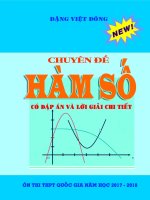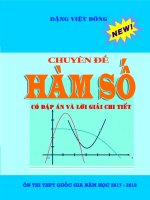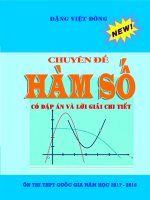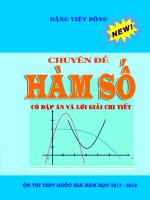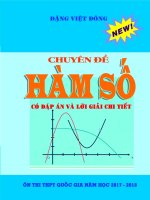TRẮC NGHIỆM CFA CÓ ĐÁP ÁN VÀ LỜI GIẢI (28 CHƯƠNG)
Bạn đang xem bản rút gọn của tài liệu. Xem và tải ngay bản đầy đủ của tài liệu tại đây (6.58 MB, 1,854 trang )
Sưu tầm: Sang Trần
CONTENT
CONTENT .............................................................................................................................1
Chapter 01 The Investment Environment ................................................................................2
Chapter 02 Asset Classes and Financial Instruments ............................................................. 90
Chapter 03 How Securities Are Traded ............................................................................... 158
Chapter 04 Mutual Funds and Other Investment Companies ............................................... 206
Chapter 05 Introduction to Risk, Return, and the Historical Record .................................... 264
Chapter 06 Risk Aversion and Capital Allocation to Risky Assets ...................................... 336
Chapter 07 Optimal Risky Portfolios .................................................................................. 399
Chapter 08 Index Models .................................................................................................... 467
Chapter 09 The Capital Asset Pricing Model ...................................................................... 535
Chapter 10 Arbitrage Pricing Theory and Multifactor Models of Risk and Return .............. 600
Chapter 11 The Efficient Market Hypothesis ...................................................................... 666
Chapter 12 Behavioral Finance and Technical Analysis ...................................................... 722
Chapter 13 Empirical Evidence on Security Returns ........................................................... 772
Chapter 14 Bond Prices and Yields ..................................................................................... 818
Chapter 15 The Term Structure of Interest Rates ................................................................ 919
Chapter 16 Managing Bond Portfolios ................................................................................ 974
Chapter 17 Macroeconomic and Industry Analysis ........................................................... 1041
Chapter 18 Equity Valuation Models ................................................................................ 1113
Chapter 19 Financial Statement Analysis .......................................................................... 1224
Chapter 20 Options Markets: Introduction ........................................................................ 1307
Chapter 21 Option Valuation ............................................................................................ 1391
Chapter 22 Futures Markets .............................................................................................. 1466
Chapter 23 Futures, Swaps, and Risk Management ........................................................... 1538
Chapter 24 Portfolio Performance Evaluation ................................................................... 1585
Chapter 25 International Diversification ........................................................................... 1662
Chapter 26 Hedge Funds................................................................................................... 1705
Chapter 27 The Theory of Active Portfolio Management .................................................. 1745
Chapter 28 Investment Policy and the Framework of the CFA Institute ............................ 1793
1
Sưu tầm: Sang Trần
Chapter 01 The Investment Environment
Multiple Choice Questions
1. The material wealth of a society is a function of _________.
A. all financial assets
B. all real assets
C. all financial and real assets
D. all physical assets
E. all commodities
2. _______ is/are a real asset(s).
A. Only land
B. Only machines
C. Only stocks and bonds
D. Only knowledge
E. Land, machines, and knowledge are real assets
3. The means by which individuals hold their claims on real assets in a well-developed
economy are
A. investment assets.
B. depository assets.
C. derivative assets.
D. financial assets.
E. exchange-driven assets.
4. _______ is/are financial assets.
A. Only bonds
B. Only machines
C. Only stocks
D. Stocks and bonds
E. Knowledge
2
Sưu tầm: Sang Trần
5. _________ financial asset(s).
A. Buildings are
B. Land is a
C. Derivatives are
D. U.S. Agency bonds are
E. Derivatives and U.S. Agency bonds are
6. Financial assets ______.
A. directly contribute to the country's productive capacity
B. indirectly contribute to the country's productive capacity
C. contribute to the country's productive capacity both directly and indirectly
D. do not contribute to the country's productive capacity either directly or indirectly
E. are of no value to anyone
7. In 2009, ____________ was the most significant real asset of Taiwanese households in
terms of total value.
A. consumer durables and semi-durables
B. foreign assets
C. real estate
D. mutual funds
E. bank loans
8. In 2009, Currency and ____________ were the least significant financial assets of
Taiwanese households in terms of total value.
A. real estate
B. mutual funds
C. life insurance reserves
D. debt securities and other
E. pension fund reserves
3
Sưu tầm: Sang Trần
9. In 2009, ____________ was the most significant financial asset of Taiwanese households
in terms of total value.
A. real estate
B. mutual funds
C. debt securities and other
D. life insurance reserves
E. deposits
10. In 2009, ____________ was the most significant asset of Taiwanese households in terms
of total value.
A. real estate
B. mutual funds
C. debt securities and other
D. life insurance reserves
E. pension fund reserves
11. In 2009, ____________ was the most significant liability of Taiwanese households in
terms of total value.
A. foreign liabilities
B. loans
C. accounts payable
D. real estate
E. other debt
12. Which of the following financial assets made up the greatest proportion of the financial
assets held by Taiwanese households?
A. Deposits
B. Life insurance reserves
C. Mutual funds
D. Debt securities and other
E. Personal trusts
4
Sưu tầm: Sang Trần
13. In 2009, _______ of the total assets of Taiwanese households were domestic financial
assets.
A. 20.4%
B. 34.2%
C. 56.5%
D. 71.7%
E. 82.5%
14. The largest component of domestic net worth of Taiwan in 2009 was ____________.
A. equipment
B. real estate
C. other assets
D. consumer durables and semi-durables
E. inventories
15. The smallest component of domestic net worth of Taiwan in 2009 was ____________.
A. equipment
B. real estate
C. other assets
D. consumer durables and semi-durables
E. inventories
16. The national net worth of Taiwan in 2009 (in NT$ 100 million) was _________.
A. NT$154,111
B. NT$264,387
C. NT$426,698
D. NT$1,302,656
E. NT$1,709,836
5
Sưu tầm: Sang Trần
17. A fixed-income security pays ____________.
A. a fixed level of income for the life of the owner
B. a fixed stream of income or a stream of income that is determined according to a specified
formula for the life of the security
C. a variable level of income for owners on a fixed income
D. a fixed or variable income stream at the option of the owner
E. a riskless return that is fixed for life
18. A debt security pays ____________.
A. a fixed level of income for the life of the owner
B. a variable level of income for owners on a fixed income
C. a fixed or variable income stream at the option of the owner
D. a fixed stream of income or a stream of income that is determined according to a specified
formula for the life of the security
E. a riskless return that is fixed for life
19. Money market securities ____________.
A. are short term
B. are highly marketable
C. are generally very low risk
D. are short term, highly marketable, and generally very low risk
E. highly marketable and generally very low risk
20. An example of a derivative security is/are ______.
A. a common share of Microsoft
B. an Intel bond
C. a commodity futures contract and a call option on Intel stock
D. a call option on Intel stock and an Intel bond
E. a common share of Intel stock
6
Sưu tầm: Sang Trần
21. The value of a derivative security _______.
A. depends on the value of the related security
B. is unable to be calculated
C. is unrelated to the value of the related security
D. has been enhanced due to the recent misuse and negative publicity regarding these
instruments
E. is worthless today
22. Although derivatives can be used as speculative instruments, businesses most often use
them to ____________.
A. attract customers
B. appease stockholders
C. offset debt
D. hedge risks
E. enhance their balance sheets
23. Financial assets can permit all of the following except ____________.
A. consumption timing
B. allocation of risk
C. separation of ownership and control
D. elimination of risk
E. easy transfer of ownership
24. The ____________ refers to the potential conflict between management and
shareholders.
A. agency problem
B. diversification problem
C. liquidity problem
D. solvency problem
E. regulatory problem
7
Sưu tầm: Sang Trần
25. A disadvantage of using stock options to compensate managers is that
A. it encourages mangers to undertake projects that will increase stock price.
B. it encourages managers to engage in empire building.
C. it can create an incentive for mangers to manipulate information to prop up a stock price
temporarily, giving them a chance to cash out before the price returns to a level reflective of
the firm's true prospects.
D. it causes managers to take undue risks.
E. it causes managers to be too conservative.
26. Which of the following are mechanisms that have evolved to mitigate potential agency
problems?
I) Compensation in the form of the firm's stock options
II) Hiring bickering family members as corporate spies
III) Underperforming management teams being forced out by boards of directors
IV) Security analysts monitoring the firm closely
V) Takeover threats
A. II and V
B. I, III, and IV
C. I, III, IV, and V
D. III, IV, and V
E. I, III, and V
27. Corporate shareholders are best protected from incompetent management decisions by
A. the ability to engage in proxy fights.
B. management's control of pecuniary rewards.
C. the ability to call shareholder meetings.
D. the threat of takeover by other firms.
E. one-share/one-vote election rules.
28. Theoretically, takeovers should result in ___________.
A. improved management
B. increased stock price
C. increased benefits to existing management of taken over firm
D. improved management and increased stock price
E. worse management and decreased stock price
8
Sưu tầm: Sang Trần
29. During the period between 2000 and 2002, a large number of scandals were uncovered.
Most of these scandals were related to
I) manipulation of financial data to misrepresent the actual condition of the firm.
II) misleading and overly optimistic research reports produced by analysts.
III) allocating IPOs to executives as a quid pro quo for personal favors.
IV) greenmail.
A. II, III, and IV
B. I, II, and IV
C. II and IV
D. I, III, and IV
E. I, II, and III
30. The Sarbanes-Oxley Act ____________.
A. requires corporations to have more independent directors
B. requires the firm's CFO to personally vouch for the firm's accounting statements
C. prohibits auditing firms from providing other services to clients
D. requires corporations to have more independent directors and requires the firm's CFO to
personally vouch for the firm's accounting statements
E. requires corporations to have more independent directors and requires the firm's CFO to
personally vouch for the firm's accounting statements, prohibits auditing firms from providing
other services to clients, and requires corporations to have more independent directors and
requires the firm's CFO to personally vouch for the firm's accounting statements
31. Asset allocation refers to ____________.
A. choosing which securities to hold based on their valuation
B. investing only in "safe" securities
C. the allocation of assets into broad asset classes
D. bottom-up analysis
E. top-down analysis
32. Security selection refers to ____________.
A. choosing which securities to hold based on their valuation
B. investing only in "safe" securities
C. the allocation of assets into broad asset classes
D. top-down analysis
E. moving assets between stocks and bonds
9
Sưu tầm: Sang Trần
33. Which of the following portfolio construction methods starts with security analysis?
A. Top-down
B. Bottom-up
C. Middle-out
D. Buy and hold
E. Asset allocation
34. Which of the following portfolio construction methods starts with asset allocation?
A. Top-down
B. Bottom-up
C. Middle-out
D. Buy and hold
E. Asset allocation
35. _______ are examples of financial intermediaries.
A. Commercial banks
B. Insurance companies
C. Investment companies
D. Credit unions
E. Commercial banks, insurance companies, investment companies, and credit unions
36. Financial intermediaries exist because small investors cannot efficiently ________.
A. diversify their portfolios
B. assess credit risk of borrowers
C. advertise for needed investments
D. diversify their portfolios, assess credit risk of borrowers, or advertise for needed
investments
E. diversify their portfolios or assess credit risk of borrowers
10
Sưu tầm: Sang Trần
37. ________ specialize in helping companies raise capital by selling securities.
A. commercial bankers
B. investment bankers
C. investment issuers
D. credit raters
E. commercial bankers, investment bankers, investment issuers, and credit raters
38. Commercial banks differ from other businesses in that both their assets and their liabilities
are mostly ________.
A. illiquid
B. financial
C. real
D. owned by the government
E. regulated
39. In 2009, ____________ was the most significant financial asset of U.S. commercial banks
in terms of total value.
A. loans and leases
B. cash
C. real estate
D. deposits
E. investment securities
40. In 2009, ____________ was the most significant liability of U.S. commercial banks in
terms of total value.
A. loans and leases
B. cash
C. real estate
D. deposits
E. investment securities
11
Sưu tầm: Sang Trần
41. In 2009, ____________ was the most significant real asset of U.S. nonfinancial businesses
in terms of total value.
A. equipment and software
B. inventory
C. real estate
D. trade credit
E. marketable securities
42. In 2009, ____________ was the least significant real asset of U.S. nonfinancial businesses
in terms of total value.
A. equipment and software
B. inventory
C. real estate
D. trade credit
E. marketable securities
43. In 2009, ____________ was the least significant liability of U.S. nonfinancial businesses
in terms of total value.
A. bonds and mortgages
B. loans
C. inventories
D. trade debt
E. marketable securities
44. In terms of total value, the most significant liability of U.S. nonfinancial businesses in
2009 was _______.
A. loans
B. bonds and mortgages
C. trade debt
D. other loans
E. marketable securities
12
Sưu tầm: Sang Trần
45. In 2009, ____________ was the least significant financial asset of U.S. nonfinancial
businesses in terms of total value.
A. cash and deposits
B. trade credit
C. trade debt
D. inventory
E. marketable securities
46. New issues of securities are sold in the ________ market(s).
A. primary
B. secondary
C. over the counter
D. primary and secondary
E. primary and over the counter
47. Investors trade previously issued securities in the ________ market(s).
A. primary
B. secondary
C. primary and secondary
D. derivatives
E. primary and derivatives
48. Investment bankers perform the following role(s) ___________.
A. market new stock and bond issues for firms
B. provide advice to the firms as to market conditions, price, etc
C. design securities with desirable properties
D. make trades for small investors
E. market new stock and bond issues for firms, provide advice to the firms as to market
conditions, price, etc, and design securities with desirable properties
13
Sưu tầm: Sang Trần
49. Until 1999, the ________ Act(s) prohibited banks in the United States from both
accepting deposits and underwriting securities.
A. Sarbanes-Oxley
B. Glass-Steagall
C. SEC
D. Sarbanes-Oxley and SEC
E. Fair Credit
50. The spread between the LIBOR and the Treasury-bill rate is called the ________.
A. term spread
B. T-bill spread
C. LIBOR spread
D. TED spread
E. FRED spread
51. Mortgage-backed securities were created when ________ began buying mortgage loans
from originators and bundling them into large pools that could be traded like any other
financial asset.
A. GNMA
B. FNMA
C. FHLMC
D. FNMA and FHLMC
E. GNMA and FNMA
52. The sale of a mortgage portfolio by setting up mortgage pass-through securities is an
example of ________.
A. credit enhancement
B. securitization
C. unbundling
D. derivatives
E. a Ponzi scheme
14
Sưu tầm: Sang Trần
53. Which of the following is true about mortgage-backed securities?
I) They aggregate individual home mortgages into homogeneous pools.
II) The purchaser receives monthly interest and principal payments received from payments
made on the pool.
III) The banks that originated the mortgages maintain ownership of them.
IV) The banks that originated the mortgages continue to service them.
A. II, III, and IV
B. I, II, and IV
C. II and IV
D. I, III, and IV
E. I, II, III, and IV
54. ________ were designed to concentrate the credit risk of a bundle of loans on one class of
investor, leaving the other investors in the pool relatively protected from that risk.
A. Stocks
B. Bonds
C. Derivatives
D. Collateralized debt obligations
E. TIPS
55. ________ are in essence an insurance contract against the default of one or more
borrowers.
A. Credit default swaps
B. CMOs
C. ETFs
D. Collateralized debt obligations
E. Collars
15
Sưu tầm: Sang Trần
Short Answer Questions
56. Discuss the agency problem in detail.
57. Discuss the similarities and differences between real and financial assets.
58. Discuss securitization as it relates to the field of investments.
16
Sưu tầm: Sang Trần
Chapter 01 The Investment Environment Answer Key
Multiple Choice Questions
1. The material wealth of a society is a function of _________.
A. all financial assets
B. all real assets
C. all financial and real assets
D. all physical assets
E. all commodities
The material wealth of a society is a function of all real assets.
AACSB: Analytic
Bloom's: Remember
Difficulty: Basic
Topic: Assets
2. _______ is/are a real asset(s).
A. Only land
B. Only machines
C. Only stocks and bonds
D. Only knowledge
E. Land, machines and knowledge are real assets
Land, machines and knowledge are real assets; stocks and bonds are financial assets.
AACSB: Analytic
Bloom's: Remember
Difficulty: Basic
Topic: Assets
17
Sưu tầm: Sang Trần
3. The means by which individuals hold their claims on real assets in a well-developed
economy are
A. Investment assets.
B. Depository assets.
C. Derivative assets.
D. Financial assets.
E. Exchange-driven assets.
Financial assets allocate the wealth of the economy. Example: it is easier for an individual to
own shares of an auto company than to own an auto company directly.
AACSB: Analytic
Bloom's: Remember
Difficulty: Basic
Topic: Assets
4. _______ is/are financial assets.
A. Only bonds
B. Only machines
C. Only stocks
D. Stocks and bonds
E. Knowledge
Machines and knowledge are real assets; stocks and bonds are financial assets.
AACSB: Analytic
Bloom's: Remember
Difficulty: Basic
Topic: Assets
18
Sưu tầm: Sang Trần
5. _________ financial asset(s).
A. Buildings are
B. Land is a
C. Derivatives are
D. U.S. Agency bonds are
E. Derivatives and U.S. Agency bonds are
Land and Buildings are real assets.
AACSB: Analytic
Bloom's: Remember
Difficulty: Basic
Topic: Assets
6. Financial assets ______.
A. directly contribute to the country's productive capacity
B. indirectly contribute to the country's productive capacity
C. contribute to the country's productive capacity both directly and indirectly
D. do not contribute to the country's productive capacity either directly or indirectly
E. are of no value to anyone
Financial assets indirectly contribute to the country's productive capacity because these assets
permit individuals to invest in firms and governments. This in turn allows firms and
governments to increase productive capacity.
AACSB: Analytic
Bloom's: Understand
Difficulty: Basic
Topic: Assets
19
Sưu tầm: Sang Trần
7. In 2009, ____________ was the most significant real asset of Taiwanese households in
terms of total value.
A. consumer durables and semi-durables
B. foreign assets
C. real estate
D. mutual funds
E. loans
See Table 1.1.
AACSB: Analytic
Bloom's: Remember
Difficulty: Basic
Topic: Assets
8. In 2009, Currency and ____________ were the least significant financial assets of
Taiwanese households in terms of total value.
A. real estate
B. mutual funds
C. life insurance reserves
D. debt securities and other
E. pension fund reserves
See Table 1.1.
AACSB: Analytic
Bloom's: Remember
Difficulty: Basic
Topic: Assets
20
Sưu tầm: Sang Trần
9. In 2009, ____________ was the most significant financial asset of Taiwanese households
in terms of total value.
A. real estate
B. mutual funds
C. debt securities and other
D. life insurance reserves
E. deposits
See Table 1.1.
AACSB: Analytic
Bloom's: Remember
Difficulty: Basic
Topic: Assets
10. In 2009, ____________ was the most significant asset of Taiwanese households in terms
of total value.
A. real estate
B. mutual funds
C. debt securities and other
D. life insurance reserves
E. pension fund reserves
See Table 1.1.
AACSB: Analytic
Bloom's: Remember
Difficulty: Basic
Topic: Assets
21
Sưu tầm: Sang Trần
11. In 2009, ____________ was the most significant liability of Taiwanese households in
terms of total value.
A. foreign liabilities
B. loans
C. accounts payable
D. real estate
E. other debt
See Table 1.1.
AACSB: Analytic
Bloom's: Remember
Difficulty: Basic
Topic: Assets
12. Which of the following financial assets made up the greatest proportion of the financial
assets held by Taiwanese households?
A. Deposits
B. Life insurance reserves
C. Mutual funds
D. Debt securities and other
E. Personal trusts
See Table 1.1.
AACSB: Analytic
Bloom's: Remember
Difficulty: Intermediate
Topic: Assets
22
Sưu tầm: Sang Trần
13. In 2009, _______ of the total assets of Taiwanese households were domestic financial
assets.
A. 20.4%
B. 34.2%
C. 56.5%
D. 71.7%
E. 82.5%
See Table 1.1.
AACSB: Analytic
Bloom's: Remember
Difficulty: Intermediate
Topic: Assets
14. The largest component of domestic net worth of Taiwan in 2009 was ____________.
A. equipment
B. real estate
C. other assets
D. consumer durables and semi-durables
E. inventories
See Table 1.2.
AACSB: Analytic
Bloom's: Remember
Difficulty: Intermediate
Topic: Assets
23
Sưu tầm: Sang Trần
15. The smallest component of domestic net worth of Taiwan in 2009 was ____________.
A. equipment
B. real estate
C. other assets
D. consumer durables and semi-durables
E. inventories
See Table 1.2.
AACSB: Analytic
Bloom's: Remember
Difficulty: Intermediate
Topic: Assets
16. The national net worth of Taiwan in 2009 (in NT$ 100 million) was _________.
A. NT$154,111
B. NT$264,387
C. NT$426,698
D. NT$1,302,656
E. NT$1,709,836
See Table 1.2.
AACSB: Analytic
Bloom's: Remember
Difficulty: Intermediate
Topic: Assets
24
Sưu tầm: Sang Trần
17. A fixed-income security pays ____________.
A. a fixed level of income for the life of the owner
B. a fixed stream of income or a stream of income that is determined according to a specified
formula for the life of the security
C. a variable level of income for owners on a fixed income
D. a fixed or variable income stream at the option of the owner
E. a riskless return that is fixed for life
A fixed-income security pays a fixed stream of income or a stream of income that is
determined according to a specified formula for the life of the security.
AACSB: Analytic
Bloom's: Remember
Difficulty: Basic
Topic: Asset Types
18. A debt security pays ____________.
A. a fixed level of income for the life of the owner
B. a variable level of income for owners on a fixed income
C. a fixed or variable income stream at the option of the owner
D. a fixed stream of income or a stream of income that is determined according to a specified
formula for the life of the security
E. a riskless return that is fixed for life
Only answer D is correct.
AACSB: Analytic
Bloom's: Remember
Difficulty: Basic
Topic: Asset Types
25


